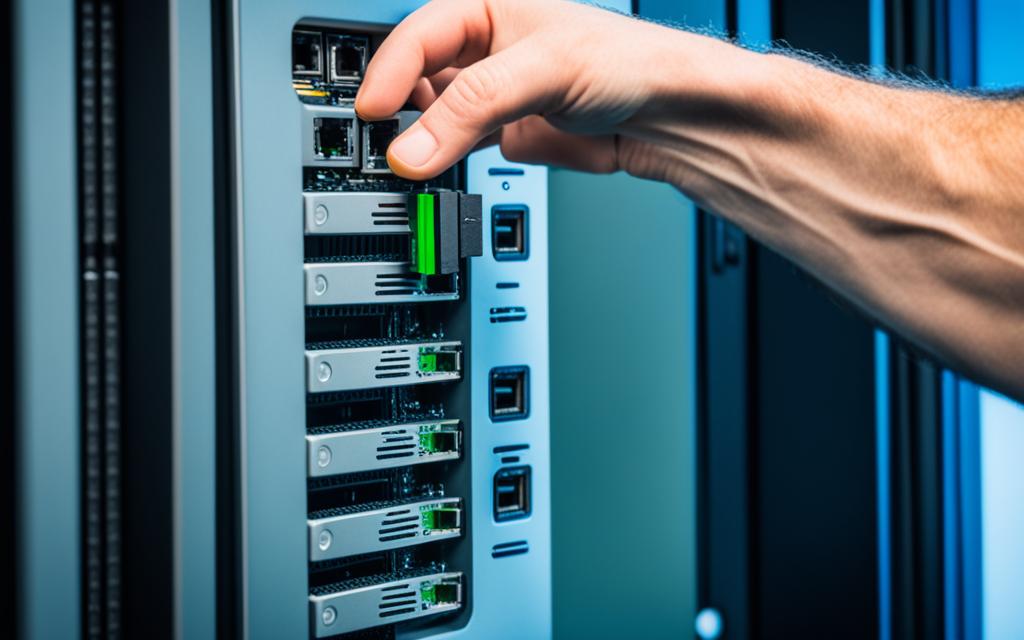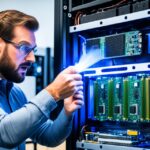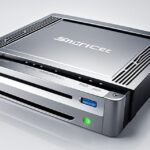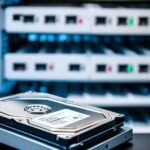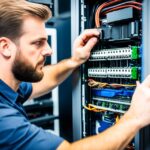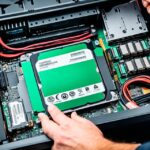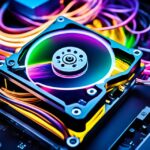Table of Contents
Have you faced an HDD not detected issue? It can seem quite scary. Hard drives, or HDDs, are key in our computers. They keep our precious memories and vital business data. When they don’t work right, like not showing up when the computer starts or when we try to connect them, it can make us worry. We fear losing all our data. Yet, it’s important to remember most times we can fix these problems. Knowing how to handle resolution of HDD detection issues is crucial. Being aware of what causes these issues helps us deal with them fast and keep our data safe.
Key Takeaways
- Understanding the causes behind HDD not detected errors is essential for effective troubleshooting.
- Regular checks of BIOS settings can aid in detecting internal HDD issues.
- Troubleshooting connection problems often resolves the detection of external hard drives.
- Implementing regular backups is a proactive measure to protect your data.
- Practising safe handling techniques can prevent physical damage to your drives.
Understanding the Causes of HDD Not Detected Errors
HDD failures to be detected come from various HDD not detected causes. These factors are vital for fixing the issue. Issues with both internal drives and external devices may prevent recognition by the system.
Common Causes for Internal and External HDD Not Detected
Both internal and external drives might not be detected for several reasons. Common causes include:
- Loose or faulty SATA cables
- Incorrect BIOS settings
- Corrupted or outdated disk drivers
- Physical drive damage
- Partition issues
These problems can lead to internal drive errors, so the system can’t see or start the drive properly. You might not see the drive in File Explorer, or get messages to format the drive1.
How Physical Damage Affects HDD Detection
Physical drive damage can hurt HDD detection a lot. Symptoms include an unresponsive system or zero-capacity drive errors. Damage, like head crashes or motor failures, makes data recovery hard without expert help1. Watching for signs of wear helps avoid issues.
Identifying Compatibility Issues With Your Operating System
Operating system compatibility issues can also cause detection problems. Drives may not be seen due to old system files or conflicting BIOS settings. Regular updates and hardware checks can spot problems early, ensuring your system works well2.
How to Fix HDD Not Detected
Fixing HDD detection issues starts with checking BIOS settings. Users need to restart their computer and go into the BIOS utility. Here, they can check if the hard drive is recognised. If not, you may need to enable the hard drive, as this often solves the problem.
Checking BIOS Settings for HDD Detection
Entering the BIOS is key to solving HDD issues. Inside BIOS, users should go to the storage or hard drive section. They must make sure their HDD is listed and active. Remember to save the settings before leaving the BIOS.
Troubleshooting Connection Problems
It’s important to check HDD connections next. both power and data cables are properly connected to the hard drive and motherboard. Many issues are due to loose or faulty cables, which stop the drive from being seen by the system3.
Assessing Drive Formatting and File System Compatibility
Formatting problems can hide an HDD. It’s wise to format the HDD to NTFS to fix issues with RAW or corrupted file systems4. If the drive is still not recognised, use storage management tools. These tools can help initialise the disk and create partitions. This makes the drive visible to the operating system. Data recovery software might help recover important files before making major changes4.
Effective Solutions for HDD Not Detected in Windows
When your Windows doesn’t notice your HDD, don’t worry. There are ways to fix this and get to your files again. By using the right steps, you can make your hard drive work once more.
Reassigning Drive Letters in Disk Management
Changing the drive letter might help your computer see the hard drive. Disk Management lets you check if it needs a new name. If there’s a letter clash, changing it solves the problem.
Updating Hard Disk Drivers to Ensure Proper Recognition
It’s key to keep HDD drivers up to date. If they’re old, your hard disk might not show up in Windows. Go to Device Manager and look for any driver updates. This helps your hard drives stay compatible.
Using Data Recovery Software to Retrieve Lost Data
Sometimes the above steps won’t fix it. That’s when data recovery software comes in handy. These programs can find important files on a hard disk Windows doesn’t see. They’re a good plan before looking for professional help.
Knowing these strategies makes a huge difference when facing HDD issues. It ensures you can reach your files when needed. A broken hard disk might mean lost data, like family pictures or crucial work docs5.
Many things can cause hard drive problems. These might be device issues or something not plugged in right. Using these tips can keep your data safe65.
Doing this boosts how well your system runs. It also keeps your important data protected6.
Preventative Measures to Avoid HDD Detection Issues
Taking steps early can help avoid hard drive problems later. Using HDD prevention tips is key to keep data safe and your external drives running well.
Implementing Regular Backups to Protect Your Data
Having a backup plan is vital to prevent data loss. Backing up data regularly helps ward off risks tied to hardware issues. Using different data backup strategies makes retrieving important files easier.
You might want to use cloud storage, external hard drives, or backup software for better safety. For hard drive troubles, companies like DataRecovery.com offer free checks and are sure to help.
Practising Safe Handling Techniques for External Drives
Physical harm often leads to external drives not being recognised. Ensuring you handle drives carefully will help them last longer. Make sure connections are tight and don’t move drives when they’re working.
Using cases for protection and keeping drives away from extreme heat or cold reduces risks significantly. Bad cable connections or rough handling are common reasons for drive errors7. How you treat external drives greatly affects their recognition.
Conclusion
To fix HDD detection problems, it’s crucial to know common issues. Sometimes, a hard drive might show in Disk Management but not Windows. Or an external USB drive won’t show up at all8. There are many ways to solve these issues, from simple connection checks to complex data recovery for drives that aren’t recognised9.
Having strong data safety measures is key to protect your information. It’s important to regularly back up your data and handle your drives carefully. This reduces the risk of losing data due to HDD detection problems10. Starting these habits can improve the reliability and life of your hard drives.
To keep your hard drive working well, making informed choices and maintaining it are essential. Every effort to understand, fix, and protect your hard drive helps to keep your data safe. It also builds confidence in your digital world.
FAQ
What should I do if my hard drive is not detected during boot-up?
Firstly, ensure the drive is correctly connected and has power. Make sure all cables are firmly in place. If issues remain, go into the BIOS settings on start-up. Here, you might need to manually make the drive visible or solve configuration problems.
How can I troubleshoot external HDD detection issues?
Start by trying other USB ports or a different USB cable for the external drive. Check if your system supports the drive. If it’s still unseen, try it on a different computer to rule out hardware faults.
What are the common signs of a corrupted hard drive?
A corrupted hard drive may show several signs. You might see frequent error messages or hear strange noises. Files could become hard to access, or the drive may not show up in your system. Run a diagnostic tool to check your drive’s health if these happen.
Can I recover lost data from a hard drive that’s not detected?
Yes, there’s hope to retrieve data from an undetected drive. Initially, attempt using data recovery software to look for files. Should that fail, a professional data recovery service might restore your data.
What preventative measures can I take to avoid HDD detection issues in the future?
To dodge future detection snags, back up data regularly. Use external drives or cloud services for backups. Treat external drives gently to prevent damage. Also, always shut down properly to protect data.
How can I check if my hard drive is properly configured in Windows?
The Disk Management tool in Windows lets you check your hard drive’s setup. Right-click the Start menu and pick ‘Disk Management.’ There, you can see if the drive has a letter assigned or needs reformatting.
Source Links
- https://www.stellarinfo.co.in/blog/how-to-fix-internal-hard-drive-not-detected/ – [Updated 2024]: How To Fix Internal Hard Drive Not Detected?
- https://www.dell.com/support/kbdoc/en-us/000132300/how-to-troubleshoot-hard-drive-or-solid-state-drive-issues-on-a-dell-computer – How to Troubleshoot Hard Drive or Solid-State Drive Issues on a Dell Computer
- https://www.lifewire.com/new-hard-drive-not-showing-up-in-windows-5078588 – New Hard Drive Not Showing Up in Windows? Here’s How to Fix It
- https://www.easeus.com/resource/hard-drive-not-showing-up-or-recognized.html – Hard Drive Not Showing Up or Detected in Windows? Learn How to Fix
- https://www.gillware.com/hard-drive-data-recovery/hard-drive-not-showing-up/ – Hard Drive Not Showing Up: Recovering HDD Not Detected
- https://www.easeus.com/recoverdata/hard-disk-not-detected.html – How to Fix Hard Disk Not Detected on Windows 10: Methods Explained
- https://datarecovery.com/rd/hard-drive-spins-but-is-not-detected-how-to-fix/ – Hard Drive Spins But Is Not Detected: How To Fix – Datarecovery.com
- https://www.diskgenius.com/how-to/hard-drive-not-showing-up.php – Hard drive not showing up or detected? Here are 7 solutions
- https://www.stellarinfo.co.in/blog/how-to-fix-external-hard-disk-drive-not-recognized/ – [Updated 2024] Fix External Hard Disk Not Recognized In Windows
- https://botrecuperacaodedados.com/hard-disk-not-detected-in-bios/ – Hard disk not detected in BIOS: see possible causes and how to solve it

